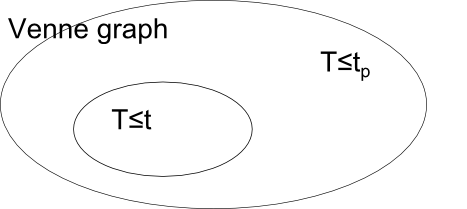Let Tc be the time of a cycle, tp the preventive maintenance time interval, and T the failure time.
The expected life cycle Tc will be the planned maintenance time tp multiplied by the probability that planned maintenance does occur, plus the expected failure time (knowing that failure occurs before tp) multiplied by the probability that failure occurs before tp. This will be expressed mathematically by:
![]() (Eqn. 1)
(Eqn. 1)
The term in Equation 1, is the expected time to failure, given that failure occurs prior to scheduled maintenance, under a policy where scheduled maintenance is carried out at time tp . We wish to show [1] that it can be expressed as
First, we recognize that the conditional distribution function of is
(Eq 2)
In the first part of Equation 2, we have simply defined the distribution function of (T≤t given that T≤tp) as ![]() . We will call this conditional distribution function, “Fc(t)”. (Recall that this is the definition of a distribution function.)
. We will call this conditional distribution function, “Fc(t)”. (Recall that this is the definition of a distribution function.)
Now, moving towards the right in Equation 2, the top condition “1, where t>tp” is easy to understand. We know that failure will have occurred prior to tp (with 100% certainty) because T≤tp is our hypothesis in Fc(t).
The bottom case ![]() requires us to know that the conditional probability P(A|B) is
requires us to know that the conditional probability P(A|B) is ![]() where A = T≤t and B = T≤tp
where A = T≤t and B = T≤tp
But we know (in the bottom case) that the intersection of T≤t and T≤tp is T≤t because the probability that T≤t is entirely within the probability space of T≤tp (since t≤tp is the bottom case). Therefore the intersection of T≤t and T≤tp is actually T≤min(t,tp)=T≤t.
In the rightmost part of Equation 2 we apply the definition of F(t) to the numerator and denominator. And, of course, we know that F(t) = 1-R(t).
Then the conditional density function of ![]() is
is
 (Eq. 3)
(Eq. 3)
We have used, in Equation 3, the fact that the density function is the first derivative of the distribution function. Therefore,
![]() (Eq 4)
(Eq 4)
Here, in Equation 4, we have invoked the definition of “Expectation” as the integral of the product of t and the density function.
© 2014, Daming Lin. All rights reserved.
- [1]in order to derive the denominator of Eq 10 of the post “Real meaning of the six RCM curves“↩


